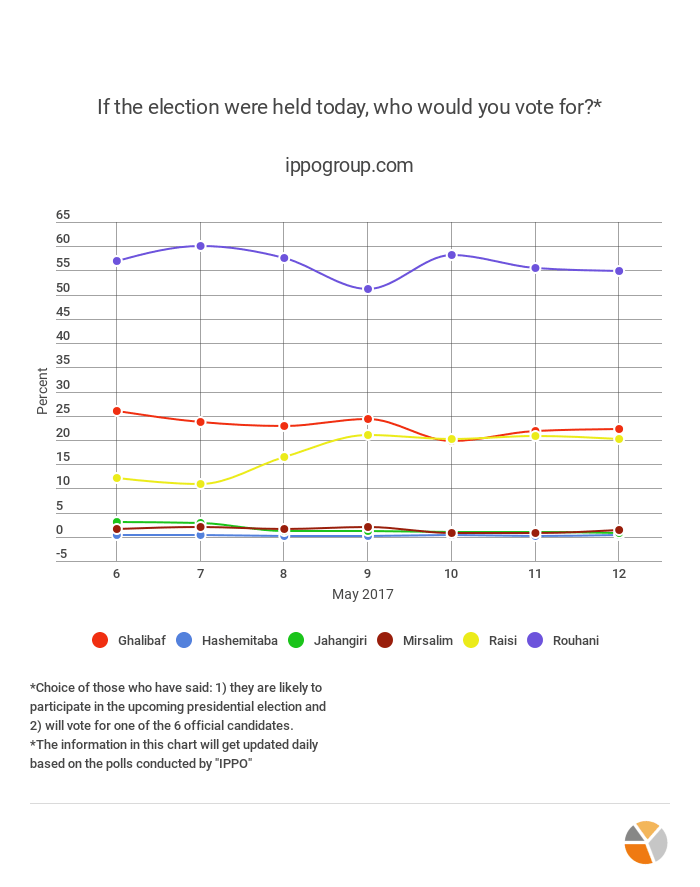Poll Results of May 14

The Vote to Elect the Iranian President
Three interesting developments in the past three days is that 1 – number of votes of Hassan Rouhani is increasing; 2- the number of votes of Mohammad Bagher Ghalibaf is decreasing; and 3 – there is a significant increase in the number of those who do not wish to disclose their vote. Two days after the last presidential debate, the IPPO poll shows that Rouhani is leading and has slightly increased his distance from his two main opponents: Mohammad Bagher Ghalibaf and Ebrahim Raisi.
In the past three days 56% of those who say: 1) they will definitely or likely participate in the May 2017 election and 2) are inclined to vote for one of the six running candidates, have voted for Hassan Rouhani as their first choice. After Rouhani, Raisi stands with 23% of the votes replacing Ghalibaf’s older position as the runner-up. Ghalibaf now stands in the third position with 19% of the respondents’ votes (see the above chart).
The growth rate of respondents that do not wish to disclose their vote is noteworthy. In terms of patterns, according to the polls the increase in the number of those who do not wish to disclose their vote somewhat corresponds to 1 – the decrease in both Rouhani and Ghalibaf’s votes; 2 – the relational decrease of the number of undecided voters and 3 – and a decrease in the number of those who name candidates that are not on the list (the common phenomenon of spoiled ballots in Iranian elections; some voters choose to vote for names that are not on the ballots, including names of celebrities, dissidents, politicians who are not running, etc… ). This pattern shows that the undecided voters and those who do not wish to disclose their vote have gradually reached a decision but they have joined ranks with those who have all along said they are voting for one of the candidates but are not willing to disclose their vote (the chart below).
Besides the figures and the polls, from an analytical perspective the increase in the number of those who do not wish to disclose their vote can be related to the level of political anxiety and fear. There is the possibility that due to the rising level of political agitation, the respondents are fearful of disclosing their final decision and as such they are not willing to reveal their vote. If this is the case, the question is who are the respondents afraid of? Finding the answer to this question can explain which forces are intimidating these respondents and it can possibly account for the political affiliations of those who are hiding their votes (i.e. Are they Rouhani, Raisi or Ghalibaf supporters?)
Second Choice Voter Preferences
In the past nine days respondents were asked: “if you were to change your mind before the Election Day, who else will you vote for instead of your first choice?” When comparing the vote-to-vote counts of the undecided voters and those who insist on only voting for one candidate (the decisive voters), once can see that as the number of undecided voters is decreasing, the number of decisive voters is increasing. However, the votes of the candidates in this category (second choice candidate) have not changed drastically when compared to the aforementioned vote-to-vote comparison between the decisive and undecided.
The Most Unfavorable Candidate
Most respondents still prefer not to indicate which candidate is so unfavorable that they will not vote for him under any circumstances. In other words, almost 47% of the respondents either say that no one among the candidates is the most unpopular or that they cannot or do not wish to name the most unfavorable candidate.
The ranking for the most unfavorable candidate is similar to the ranking of the most favorable candidate. The highest rating of unfavorability is of Hassan Rouhani with 8% and after him Ghalibaf (5%) and Raisi (4%). Jahangiri and Hashemitaba with less that 2% of the unpopularity vote are standing together as the least unfavorable candidates.
Voter Turnout
The voter turnouts that participants have mentioned have remained more or less steady in the past nine days. However the rate of respondents’ own participation is increasing. In the past three days 74% of respondents say they are likely or very likely to vote in the May 2017 presidential election. In contrast, 16% say there is little chance or very little chance that they will participate in the elections. Besides the 6% of respondents that say they are somewhat likely to participate in the elections, 4% of the respondents have not yet reached a decision with regards to participation.
Projections of election participation rates in polls such as this one does not neatly translate to voter turnout rate on the day of the election. Projections of the voter turnout in polls are often more than the actual turnout on the day of the election; this is not unique to the Iranian context and is relevant to all pre-election polling.
Following Presidential Debates
The third presidential debate seems to have attracted more attention. Two days after the last debate among the candidates, more respondents are saying that they are following the debates. The number respondents who confirm they follow presidential debates are gradually increasing. It should be noted that respondents’ perception of “following debates” is both following the actual debates and the media coverage of the debates as well as candidate’s advertisements broadcasted on the media. More than 62% of the respondents say they have been following the election debates and 33% of them say that they have not been following the debates or that they are not aware such debates even exists. The current figures in this category have been gathered in the past three days. As such, more possible increase in the number of participants who have most recently joined the crowd that follows the debate(s) will be reflected in future polls.
The Alternative Vote 1
Aside from the aforementioned patterns related to the “second choice candidate”, now that data has accumulated we can better respond to this question: “If the respondents were to change their decision until the Election Day, who seems to be the more likely second choice alternative?”
The results show that voters are more determined to vote for Hassan Rouhani. 23% of respondents say that they will not vote for any other candidate, except for Rouhani. The figures for those who will not vote for any other candidate except for Ghalibaf and Raisi are 16% and 13% respectively.
More so, 24% of those who chose Rouhani as their first choice are willing to vote for rival candidates Ghalibaf and Raisi. While 50% of Ghalibaf voters and 61% of Raisi voters are willing to vote for their first choice candidates’ opponent.
Overall, of the 25% of voters who are voting for Ghalibaf and Raisi, 36% are willing to vote for Rouhani as the alternative candidate.
15% of respondents who have chosen Rouhani as their first choice say that if they do not vote for Rouhani, they will vote for Ghalibaf. In contrast, 20% of Ghalibaf voters say if they do not vote for Ghalibaf, they will vote for Rouhani. 11% of Rouhani voters say that if they do not vote for him, they will vote for Raisi; while 16% of Raisi voters choose Rouhani as their second alternative vote.
Comparing alternative choices between Raisi and Ghalibaf’s voters: 44% of the Raisi voters choose Ghalibaf as their second alternative; yet 30% of Ghalibaf voters are willing to choose Raisi if they were not to vote for Ghalibaf.
The Alternative Vote 2
Overall, for 36% of the votes that Rouhani receives as an alternative candidate for Ghalibaf and Raiais, he gives %26 of his voters to the two opponents. In other words, the net balance of Rouhani’s votes in this category is +10%. Ghalibaf on the other hand receives only 50% of the voters from the pool of Rouhani and Raisi’s first choice voters while giving 59% of his voter to Rouhani and Raisi. In other words, the net balance of Ghalibaf’s votes, as a second choice alternative is -9%. Raisi also receives a negative balance of %10 percent. For every 51% of voters he loses to Ghalibaf and Rouhani in the second choice category, Raisi only receives 41% from the pool of Ghalibaf and Rouhani’s first choice ballots.
Survey Methodology:
- This polling was carried out at a national level in Iran from 12 May 2017 to 14 May 2017 and reported on a three-day rolling average basis.
- The interviews were conducted via phone. Interviewers were trained – both for general skills of phone polling and for the specific needs of this survey. The interviewers were selected post training after passing an interviewing skills exam.
- The sample size was 1122 Iranians, 18 years and older, who were residing in Iran and were selected randomly.
- Sampling methodology is a two-stage proportional sampling. It’s on the basis of each of the service operators’ market share and then simple random sampling.
- Assuming maximum variation, the results of this survey can generalize to the whole of the 18 years and older Iranian (resident in Iran) with a margin of error of ±2.93 to ±4.30 for the 95% confidence interval (based on responses to questions).
- The data were weighted based on the last available National Iranian Census (2011) with gender, age group and place of residence (urban/rural) as weighting variables.
- Farsi native speaking interviewers conducted the interviews during daylight hours, local time.
- The results of each interview was assessed twice by the interviewer and the supervising team – in terms of respondent’s trust in the interviewer and the interviewer’s assessment of the respondents’ honesty.
- Those respondents who had received very low scores for trust and honesty have been removed from the random sample.


